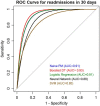Analysing repeated hospital readmissions using data mining techniques
- PMID: 31215903
- PMCID: PMC6452835
- DOI: 10.1080/20476965.2018.1510040
Analysing repeated hospital readmissions using data mining techniques
Abstract
Few studies have examined how to identify future readmission of patients with a large number of repeat emergency department (ED) visits. We explore 30-day readmission risk prediction using Microsoft's AZURE machine learning software and compare five classification methods: Logistic Regression, Boosted Decision Trees (BDTs), Support Vector Machine (SVM), Bayes Point Machine (BPM), and Two-Class Neural Network (TCNN). We predict the last readmission visit of frequent ED patients extracted from the electronic health records of their 8455 penultimate visits. The methods show differential improvement, with the BDT indicating marginally better AUC (area under the ROC curve) than logistic regression and BPM, followed by the TCNN and SVM. A comparison of BDT and Logistic Regression results for correct and incorrect classification highlights the similarities and differences in the significant predictors identified by each method. Future research may incorporate time-varying covariates to identify other longitudinal factors that can lead to readmission risk reduction.
Keywords: Hospital readmissions; boosted decision tree; logistic regression; predicting readmissions; support vector machine; two-class neural network.
Figures
Corrected and republished from
-
Analysing repeated hospital readmissions using data mining techniques.Health Syst (Basingstoke). 2017 Nov 7;7(2):120-134. doi: 10.1080/20476965.2017.1390635. eCollection 2018. Health Syst (Basingstoke). 2017. Corrected and republished in: Health Syst (Basingstoke). 2018 Nov 09;7(3):166-180. doi: 10.1080/20476965.2018.1510040. PMID: 31214343 Free PMC article. Corrected and republished.
Similar articles
-
Analysing repeated hospital readmissions using data mining techniques.Health Syst (Basingstoke). 2017 Nov 7;7(2):120-134. doi: 10.1080/20476965.2017.1390635. eCollection 2018. Health Syst (Basingstoke). 2017. Corrected and republished in: Health Syst (Basingstoke). 2018 Nov 09;7(3):166-180. doi: 10.1080/20476965.2018.1510040. PMID: 31214343 Free PMC article. Corrected and republished.
-
Predicting 30-day Hospital Readmission with Publicly Available Administrative Database. A Conditional Logistic Regression Modeling Approach.Methods Inf Med. 2015;54(6):560-7. doi: 10.3414/ME14-02-0017. Epub 2015 Nov 9. Methods Inf Med. 2015. PMID: 26548400
-
Seminal quality prediction using data mining methods.Technol Health Care. 2014;22(4):531-45. doi: 10.3233/THC-140816. Technol Health Care. 2014. PMID: 24898862
-
Application of machine learning in predicting hospital readmissions: a scoping review of the literature.BMC Med Res Methodol. 2021 May 6;21(1):96. doi: 10.1186/s12874-021-01284-z. BMC Med Res Methodol. 2021. PMID: 33952192 Free PMC article.
-
Predictive models for hospital readmission risk: A systematic review of methods.Comput Methods Programs Biomed. 2018 Oct;164:49-64. doi: 10.1016/j.cmpb.2018.06.006. Epub 2018 Jun 28. Comput Methods Programs Biomed. 2018. PMID: 30195431
Cited by
-
Predicting Readmission Charges Billed by Hospitals: Machine Learning Approach.JMIR Med Inform. 2022 Aug 30;10(8):e37578. doi: 10.2196/37578. JMIR Med Inform. 2022. PMID: 35896038 Free PMC article.
References
-
- Amarasingham R., Moore B. J., Tabak Y. P., Drazner M. H., Clark C. A., Zhang S., … Halm E. A. (2010). An automated model to identify heart failure patients at risk for 30-day readmission or death using electronic medical record data. Medical Care, 48(11), 981–988.10.1097/MLR.0b013e3181ef60d9 - DOI - PubMed
-
- Artetxe A., Beristain A., Graña M., & Besga A. (2016). Predicting 30-day emergency readmission risk. In European Transnational Education (pp. 3–12). Springer.
Publication types
LinkOut - more resources
Full Text Sources



